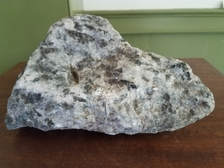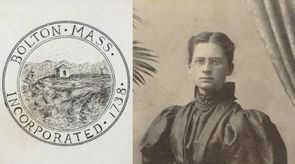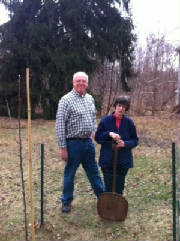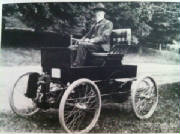BOLTON- NOW AND THEN

BOLTONITE
Boltonite is an unusual form of Forsterite known as White Olivine. Boltonite was given its name due to its 'discovery' on Rattlesnake Hill in the town of Bolton, MA. Boltonite was originally believed by locals to be extremely rare, and it was even rumored that Boltonite could only be found on Rattlesnake Hill and Mount Vesuvius. Due to Boltonite's perceived rareness, the Conservation Commission adopted a policy that prohibited the removal of minerals, animals, and plants from Bolton conservation land in order to prevent Rockhounds from removing large quantities of the mineral from the conservation land. It was later found in an analysis by the Harvard Geology Department that Boltonite is not as rare as it was first thought and is actually just White Olivine and can, indeed, be found in many locations around the world other than Bolton and Mount Vesuvius.
Boltonite is an unusual form of Forsterite known as White Olivine. Boltonite was given its name due to its 'discovery' on Rattlesnake Hill in the town of Bolton, MA. Boltonite was originally believed by locals to be extremely rare, and it was even rumored that Boltonite could only be found on Rattlesnake Hill and Mount Vesuvius. Due to Boltonite's perceived rareness, the Conservation Commission adopted a policy that prohibited the removal of minerals, animals, and plants from Bolton conservation land in order to prevent Rockhounds from removing large quantities of the mineral from the conservation land. It was later found in an analysis by the Harvard Geology Department that Boltonite is not as rare as it was first thought and is actually just White Olivine and can, indeed, be found in many locations around the world other than Bolton and Mount Vesuvius.

TOWN SEAL AND EVANGELINE YOUNG
The town seal was adopted in 1900 and has appeared on all official town papers since its inception. The center of the seal contains a drawing of Bolton's old powderhouse that sits on the hill behind town hall. The seal was drawn in 1899 by Evangeline Young who was working as a teacher and principle at the Houghton High School at the time in order to pay for medical school. Although art was not her career focus, Evangeline had been instructed in the art of drawing as a young girl as it was considered proper for a young women at the time. After working in Bolton for a year, Evangeline had gathered enough money to attend medical school at Tufts University. After graduating, Evangeline became a well known Doctor for women and children, opening a clinic for poor families and holding nutrition classes for mothers. Evangeline was also a political activist who advocated for women's suffrage and access to birth control as well as expressing concern for overpopulation and pollution. Unfortunately, like many other scientists of her time, Evangeline saw Eugenics as a solution to overpopulation, and she became heavily involved in the eugenics movement, eventually founding the Boston School of Eugenics in 1912.
The town seal was adopted in 1900 and has appeared on all official town papers since its inception. The center of the seal contains a drawing of Bolton's old powderhouse that sits on the hill behind town hall. The seal was drawn in 1899 by Evangeline Young who was working as a teacher and principle at the Houghton High School at the time in order to pay for medical school. Although art was not her career focus, Evangeline had been instructed in the art of drawing as a young girl as it was considered proper for a young women at the time. After working in Bolton for a year, Evangeline had gathered enough money to attend medical school at Tufts University. After graduating, Evangeline became a well known Doctor for women and children, opening a clinic for poor families and holding nutrition classes for mothers. Evangeline was also a political activist who advocated for women's suffrage and access to birth control as well as expressing concern for overpopulation and pollution. Unfortunately, like many other scientists of her time, Evangeline saw Eugenics as a solution to overpopulation, and she became heavily involved in the eugenics movement, eventually founding the Boston School of Eugenics in 1912.

BOLTON'S MOTHER APPLE
Tender, sweet and juicy with an aromatic flesh, Mother Apple is considered one of the finest eating apples. Now an heirloom variety, Mother was developed in Bolton in the early 1800's by Steven Partridge Gardner. Having served as a general in the militia, Gardner came to Bolton in 1798, married Achsah Moore, and built his house on the Great Raod (#642, now the parsonage for the First Parish Church). Gardner ran a store in a building behind his house, stocking it with sundry items, some earmarked for the poor. The store must have also sold spirits because he held a liquor license from 1793 to 1805. Gardner's interest in pomology led him to create Mother. Described as a medium-sized with golden yellow skin with red striping, mother never reached commercial success because it does not keep well and ripens unevenly. This apple is best eaten right from the tree. Mother Apple still exists at such places as Nashoba Valley Winery, Sturbridge Village and Tower Hill. Anyone interested in growing their own Mother Apple can contact the Worcester Horticultural Society; they sell the scion wood for grafting in late winter. Roger Breeze and Alice Coggeshall (above left) planting the new Mother Apple at Sawyer House in 2013.

BUYING A CAR.......
Buying a new car can be a daunting task. Hybrid or all gas? SUV or sedan? What can $25,000.00 get you? But back in simpler times: Charlie Mace and his wife Sarah lived most of their married life in the center of town. They could walk to anything going on in Bolton, and for any other purpose a horse and buggy filled their needs. But around 1910, Charlie got the urge to buy an automobile. With the closest car dealership being in Boston, Charlie boarded a train one fine spring day to car shop along Commonwealth Avenue. After finding one to his liking, he paid in cash and then informed the salesman that there was one little problem: "I don't know how to drive." After a few trips around the block with the salesman, Charlie started home, gaining confidence with every mile, and arrived back in Bolton without an accident!
Buying a new car can be a daunting task. Hybrid or all gas? SUV or sedan? What can $25,000.00 get you? But back in simpler times: Charlie Mace and his wife Sarah lived most of their married life in the center of town. They could walk to anything going on in Bolton, and for any other purpose a horse and buggy filled their needs. But around 1910, Charlie got the urge to buy an automobile. With the closest car dealership being in Boston, Charlie boarded a train one fine spring day to car shop along Commonwealth Avenue. After finding one to his liking, he paid in cash and then informed the salesman that there was one little problem: "I don't know how to drive." After a few trips around the block with the salesman, Charlie started home, gaining confidence with every mile, and arrived back in Bolton without an accident!